LED lighting for kitchen cabinets: what happens and how to choose?
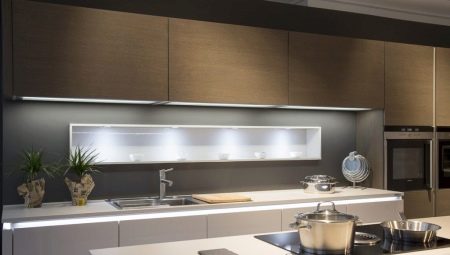
LED cabinet lighting is a very popular solution for kitchen furnishings. Well-designed lighting contributes to a comfortable cooking environment and effectively accentuates the design of the room.
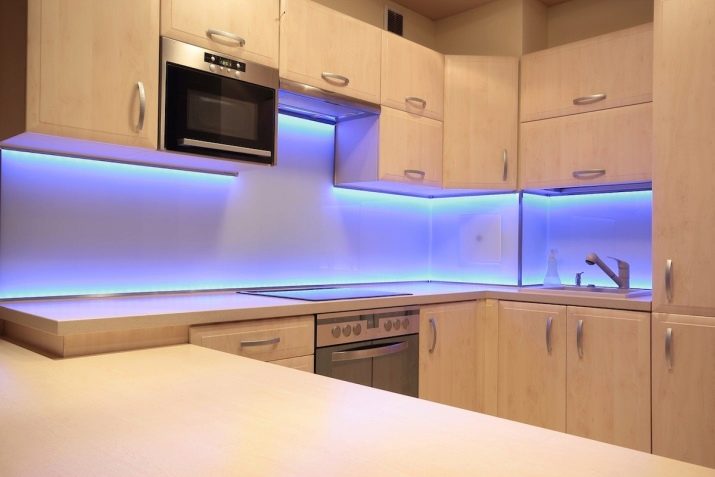
Peculiarities
Backlighting for wall cabinets is an important link in kitchen lighting and allows you to zoning the kitchen. With the help of light, you can not only tastefully decorate the kitchen space, but also make the workplace as convenient and functional as possible. Lighting can be mounted using different types of lamps, however, the most demanded today are LEDs.
An LED is a semiconductor that emits light when electricity passes through it. Diode models are available in a wide color range, perfectly illuminate small spaces and consume a minimum amount of electricity.
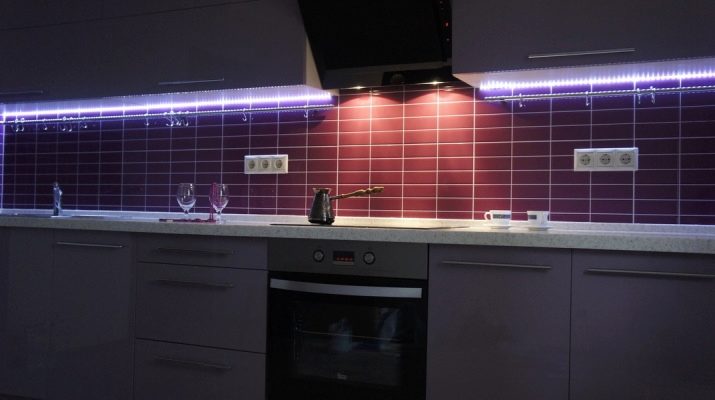
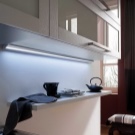
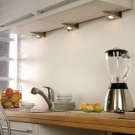
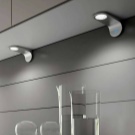
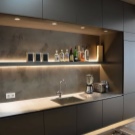
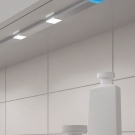
In most cases, they use LED strip. It is placed under the lower tier of wooden kitchen cabinets or inside glass models. The bottom arrangement of the LEDs gives the furniture a floating look and visually lightens bulky kitchen sets.
In addition, the variety of colors of modern LED elements allows you to choose lighting depending on its functional purpose. So, if the space under the cabinets is illuminated exclusively for decorative purposes, then an excellent solution would be a colored LED strip. If only the working area is highlighted, then it is better to opt for white light. It does not distort the shade of the food and perfectly illuminates the cutting table.
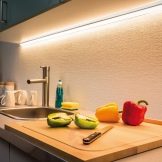
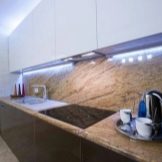
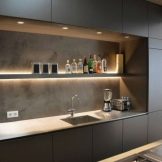
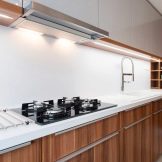
Advantages and disadvantages
The demand and high popularity of LED backlighting are due to a number of indisputable advantages of this type of lighting.
- The ease of installation of LEDs allows you to mount the lighting yourself, without resorting to the services of specialists.
- Long service life allows LEDs to be used for 2 decades and not to spend money on replacing them. This is one of the main advantages of diodes over incandescent lamps, which have to be changed quite often.
- The minimum power consumption makes LEDs the leader in efficiency and allows you to significantly save your budget.
- Regardless of the form of release, the LEDs begin to glow at full power from the first second after switching on. They do not require warm-up time, and the number of on / off switches does not in any way affect the duration of their operation.
- Unlike incandescent bulbs, LED light sources do not heat up by themselves and do not heat up the air in the room. This is especially important in the kitchen, where the air from a working stove is already very hot.
- The LED backlight is fireproof: it does not explode if water drops accidentally hit it and can work in high humidity conditions.
- A wide range of products allows you to choose a lighting element for any type of kitchen cabinets, regardless of their configuration and design. Moreover, there are a lot of wireless battery-powered surface-mounted luminaires that do not require pulling wires to the nearest power source to connect them.
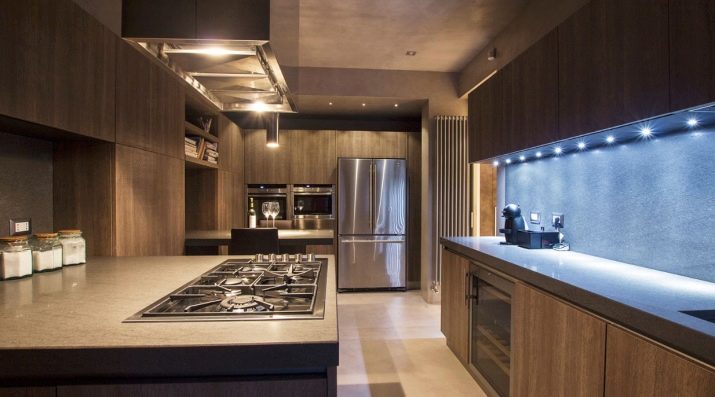
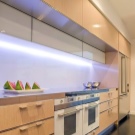
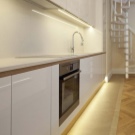
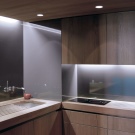
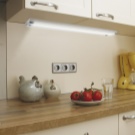
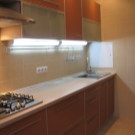
There are practically no drawbacks to LED backlighting. The disadvantages include only its high cost, which is a very conditional disadvantage, since the costs are quickly recouped due to low energy consumption and a long service life.
Views
The classification of LED lamps for the kitchen is made according to such characteristics as the form of release and the degree of moisture protection. According to the first criterion, 3 types of products are distinguished: these are linear and point models, as well as an LED strip.
- Linear luminaires are sold in whole sets, including several ready-made modules at once, and outwardly resemble fluorescent lamps. Such kits are equipped with everything necessary for self-connection, including fasteners and adapters. During installation, it is enough to connect them together in a single circuit and, as a result, get a rather long light source. Linear models are very convenient for illuminating both the entire work area and one cutting table: they give uniform light and do not blind the eyes. By their design, linear luminaires can be overhead, pendant, recessed and corner, which allows you to choose the option of any type of installation.
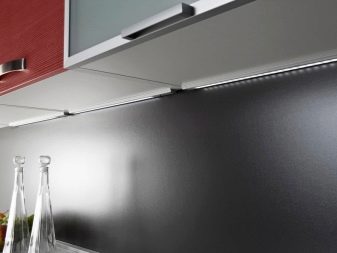

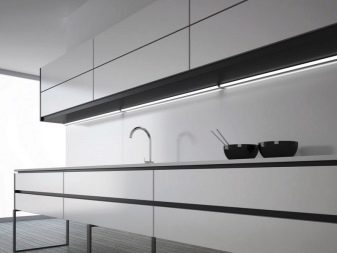
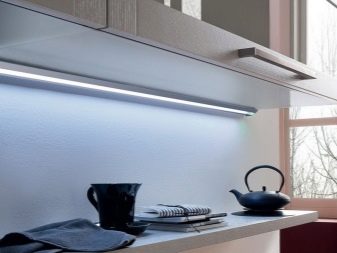
- Spot ready-made LED luminaires according to the principle of operation, they differ little from linear models, with the only difference that they are small independent products of a round, square or triangular shape, and are not assembled into a general structure. Such diodes have a cut-in or surface-mounted design, a very small thickness and a long service life. Mortise requires the formation of a niche or hole and is built into the bottom panel of the cabinet. They are flush with its outer surface and look very organic. Installation of built-in models requires some experience and accuracy, so it's better to entrust it to professionals. Overheads are mounted on top of the cabinet wall and do not require cutting out niches.
Point and linear models are often equipped with touch controls that allow you to turn on and off the lighting with one touch of your hand. It is very convenient in a kitchen, and such models look quite aesthetically pleasing.

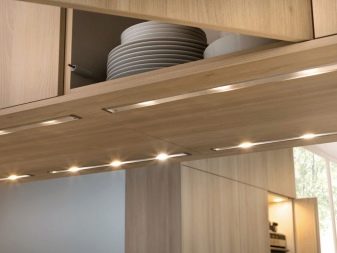

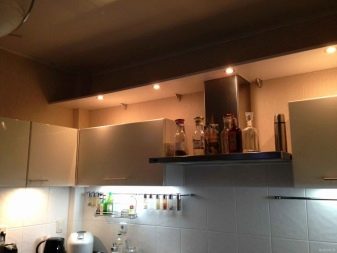
- LED Strip Light is the most popular option for kitchen lighting and has a wide range of colors, ease of installation and reasonable cost. Multi-colored ribbons are used not only to illuminate the working area, but also as a decorative element. Their soft and beautiful light can make the kitchen cozy and give it a romantic look.
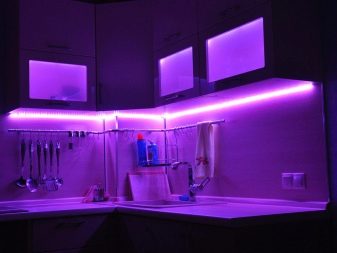
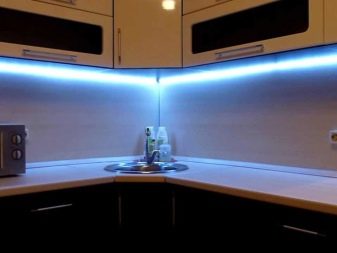
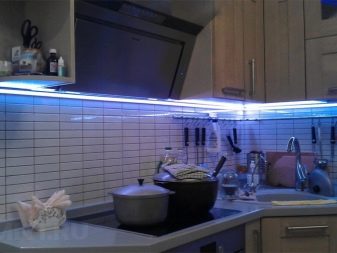
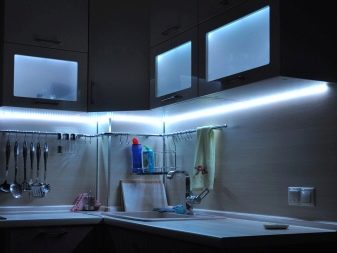
The next criterion for the classification of LED light sources is the class of moisture protection. It is always indicated on the marking and must be taken into account when choosing kitchen lighting.
- Products marked IP 20 absolutely not suitable for damp rooms, to which the kitchen belongs, and are not recommended as a lighting device for work areas.
- Models with protection class IP 41-65 well protected from moisture ingress and suitable for use in kitchens.
- The most powerful and safest are LEDs marked with IP 68. They have an absolute level of protection and can be installed even on the bottom of the pool.
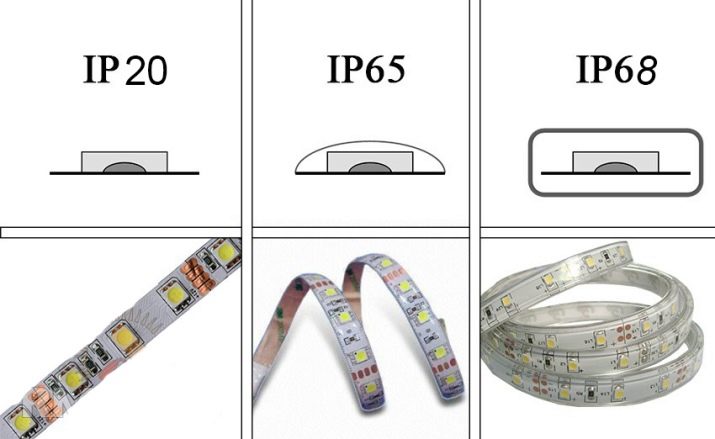
Another sign of difference is the color of the light output. According to this criterion, models are divided into monochrome and multi-colored. The former are used to illuminate the working area, and the latter are often used to illuminate wall panels and kitchen aprons.
How to choose?
When choosing LED lighting for kitchen cabinets, you need to take into account a number of important points. So, if you decide to purchase an LED strip, then you should decide on its size. The modern lighting market offers a wide range of LEDs with a wide variety of sizes and shapes. Therefore, the choice of the desired option depends on the functions that will be assigned to the backlight.
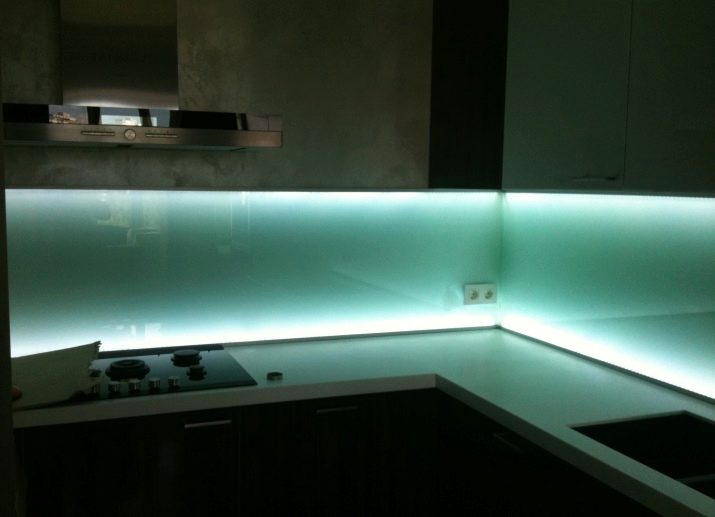
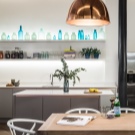
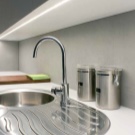
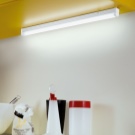
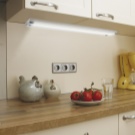
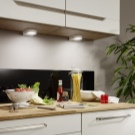
If the tape is purchased as additional illumination of the working area, where uniform and rather bright light is required, then it would be better to purchase wide monochrome products that will be able to illuminate the cutting table well and will not distort the color of the products.
For such purposes, it is well suited single-row tape in a closed case, 13 mm wide... As for the height of the product, it all depends on the type of protection. Thus, the minimum tape thickness in an open case is 2.2 mm, while closed models can have a thickness of 5.5 mm or more. That's why the choice of thickness depends on the safety requirements for a particular area of the kitchen, and remains at the discretion of the owners.
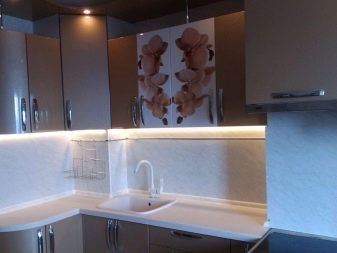
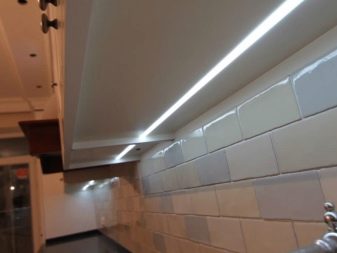
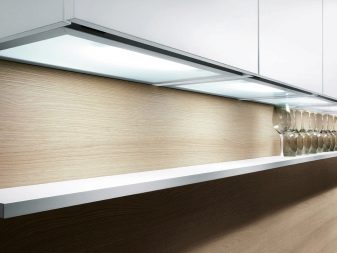
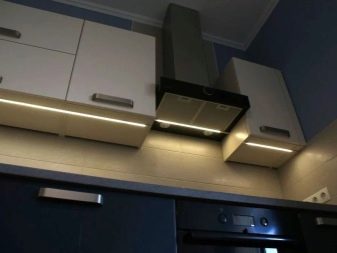
If the LED backlighting will be used exclusively for decorative purposes and is intended to emphasize the design of the room as much as possible, then in such cases you can stop on multi-colored single-row models 8 mm wide and up to 3 mm high. And vice versa - in cases where an increase in the illuminated area and backlight intensity is required, it is better to use two-row models with a width of 15 mm or more with large LEDs.
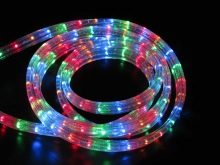

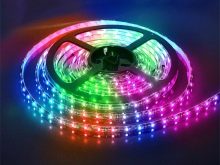
As for the brightness of the lighting, then each tape has a marking indicating how many LEDs are located on one running meter. For example, a 120 led / m mark means that each meter of tape contains 120 LEDs.
In this case, we are talking about a two-row model, single-row samples with LEDs of the same size have only 60 diodes per meter, which corresponds to a marking of 60 led / m.
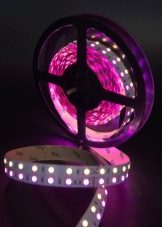
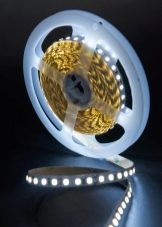
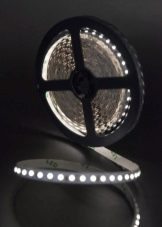
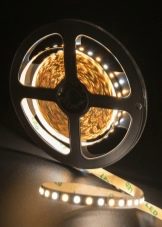
In addition to the number of LEDs per running meter, their size also affects the light intensity. There are both very small diodes with a size of 3.5x2.8 mm, and rather dimensional samples of 5.0x5.0 and 5.7x3.0 mm.
For ease of designation, the marking of such LEDs looks like SMD3528, SMD5050 and SMD5730 respectively. A wide variety of standard sizes of LED elements allows them to be placed on the tape in quantities from 30 to 240 pieces. The LED strip for kitchen lighting is available in reels up to 5 m long.This form of release is very convenient and allows you to purchase exactly as much tape as is required to decorate the cabinet.
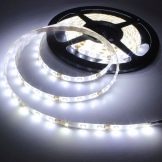
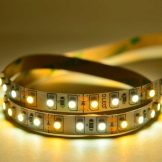
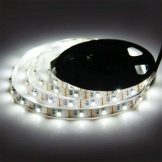
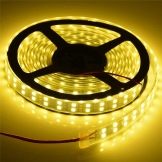
The next important point is the choice of a power supply (transformer). The main thing is to choose such an option so that its power is sufficient for the correct operation of the lamp, but at the same time it is not excessively high. Calculating the optimal power is very simple, you just need to use a special formula. For example, for an LED strip with a length of 5 m, a power of 12 W and a size of LED elements of 5x5 mm, the calculation will look like this: multiply 12 W by 5 m and get 60.
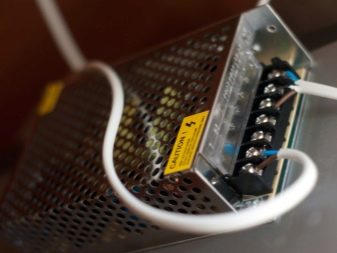
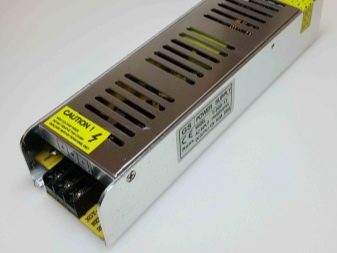
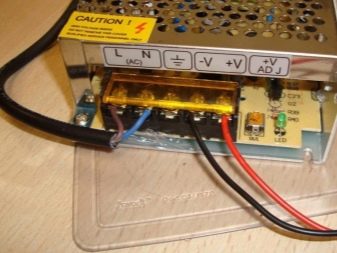
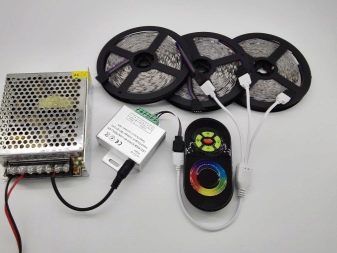
Then we provide some power reserve, multiplying this number by a factor of 1.25. As a result, we get the number 75, which will mean the power of the transformer. Thus, for a 5-meter 12 W tape with large 5x5 mm LEDs, a 75 W transformer is required.
This formula is universal and can be used for LEDs of any power and length.
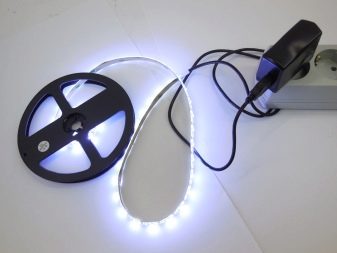
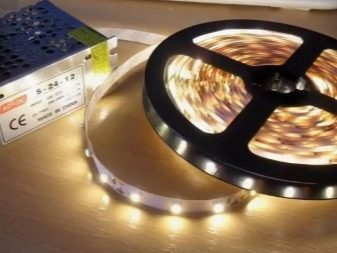
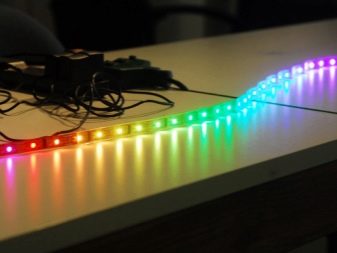
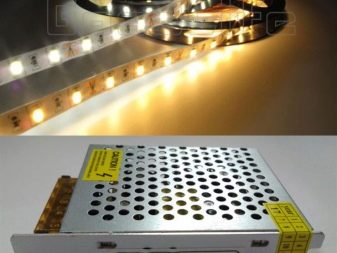
In addition to power, when choosing a transformer it is necessary to pay attention to its body. To date, power supplies are produced in plastic, aluminum solid and aluminum perforated housings.
Plastic models are quite sealed, small in size and light in weight. Solid aluminum options are much more expensive than plastic ones and are characterized by resistance to external mechanical stress. Perforated housings are large and relatively inexpensive. Their significant disadvantage is the need for additional moisture protection, and the benefits include the ability to use one device at once for several lines of LED backlighting.
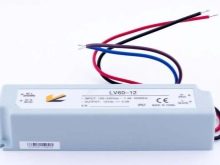
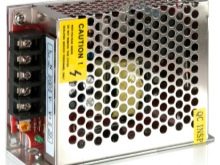
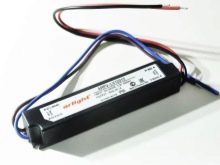
The next criterion for choosing a backlight for a kitchen cabinet is selection of a switch, which can be touch, infrared or push-button... The latter is a simple mechanical design and operates with a button connected to a relay. The relay, in turn, closes or opens the circuit and is an old proven device.
The touch switches are equipped with particularly sensitive sensors that instantly react to the touch of your fingers. Infrared models are equipped with a built-in motion detector and respond to a wave of the hand.
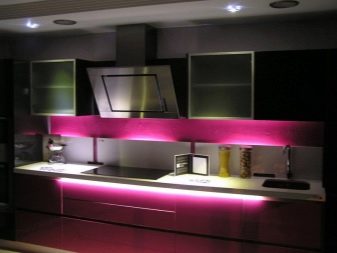
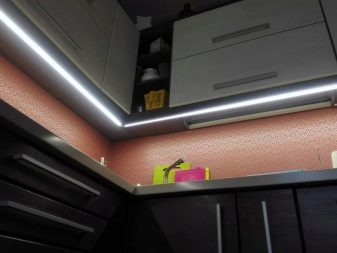
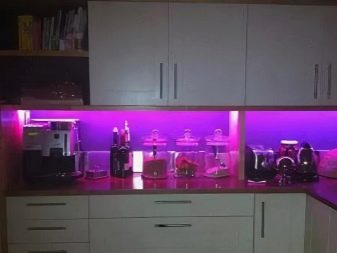

If the backlight is purchased for decorative purposes, then it is better to opt for models with a dimmer and a control unit... The first is a special switch designed to regulate the luminous flux, and the second is necessary to enable various kinds of effects, such as blinking, flickering, overflow, and the like.
In addition, when selecting the backlight it is necessary to focus on the products of well-known manufacturers who have a good reputation and produce quality goods.
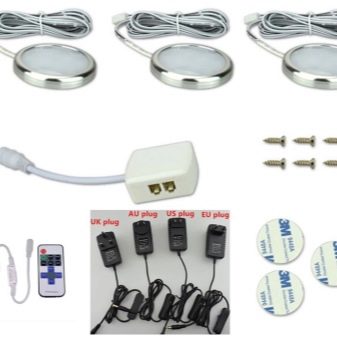
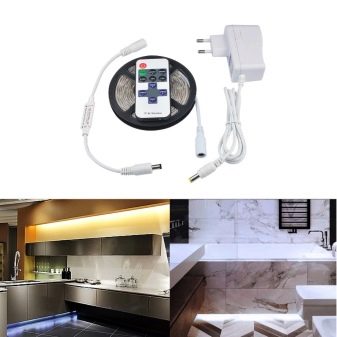
Installation nuances
The complexity of installing LED lighting under kitchen cabinets depends on the form of production of the LED lamp. So, the installation of overhead point models powered by batteries does not cause any difficulties, and any housewife can do it. The situation with the installation of the LED strip is a little more complicated, before installing it, it is advisable to familiarize yourself with some of the subtleties of the process.
- The tape can only be cut in certain places. Usually the manufacturer puts special marks on which the cut can be made. For this, you can use simple scissors, since the substrate with copper tracks is not too thick and is perfectly cut.
- If it is necessary to install several long tapes at once, then the connection is made to the common block and is performed in parallel, observing the polarity.
- It is advisable to connect the electrical cable connecting the power supply to the LED strip using soldering, since it is much more reliable than connectors.The joints are necessarily sealed by crimping with heat shrink tubes. The use of electrical tape is also allowed, however, such connections will look ugly.
- Installation of a rocker or pushbutton switch is made before the power supply, and a dimmer or RGB-block - after it. The touch switch can be installed directly in front of the tape.
- You can attach the LED strip to the underside of the kitchen cabinet using double-sided adhesive tape. Before gluing the LED, you need to thoroughly degrease the surface using a compound that cannot damage the furniture surface. First, it is recommended to lightly "bait" the tape in several places, make sure that it lies exactly along the markings, and only then press it along its entire length. You can often find models equipped with an adhesive surface, which greatly facilitates installation and does not require the purchase of double-sided tape.
- In order for the LEDs located under the cabinet not to blind others, but to illuminate only the working area, it is recommended to use special boxes that direct the light flux downward.
- Do not twist or bend the tape to extend the life of the backlight.
- Sometimes the installation of LED lights requires niches and holes, which can be made with an ordinary electric jigsaw.
- To create the effect of light diffusion and light spots, you can use an aluminum profile equipped with high sides or a light diffusing film.
If there is a desire to disguise the LED strip as much as possible and make it invisible on the furniture surface, then you can use a guide profile that has the same color as the cabinet.
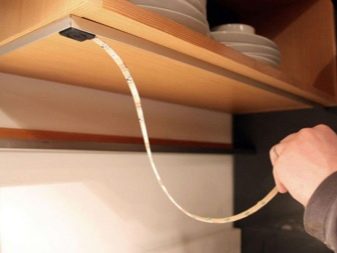

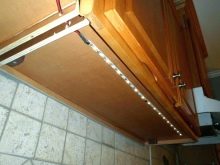
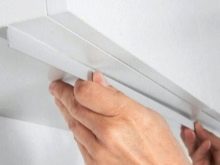
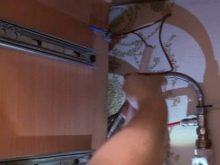
Beautiful examples in the interior
LED luminaires not only illuminate the workspace well, but they are also an effective tool for completing the image of the kitchen.
- Beautiful lighting on a corner set is a stylish solution for a modern kitchen.
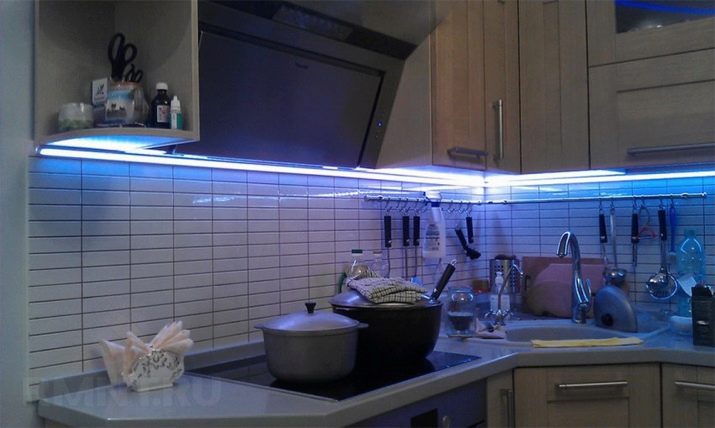
- The combination of interior lighting of cabinets with lighting of the working area looks very impressive and original.
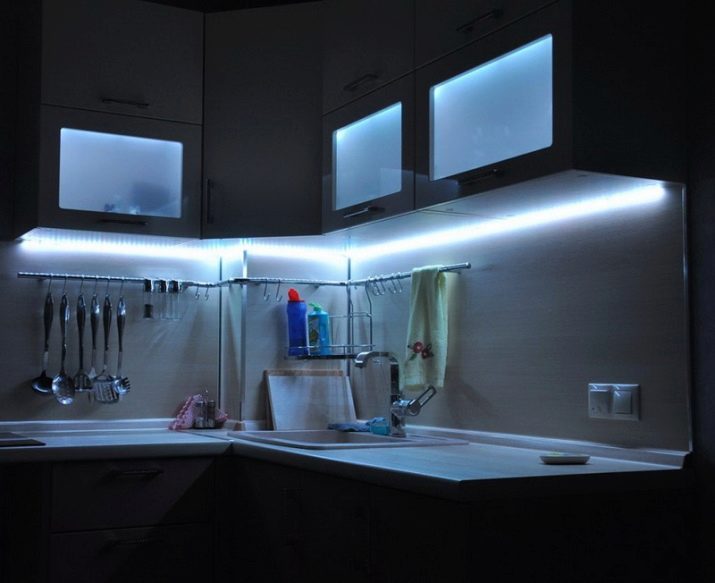
- The linear LED luminaire in a closed case does not dazzle the eyes and looks very neat.
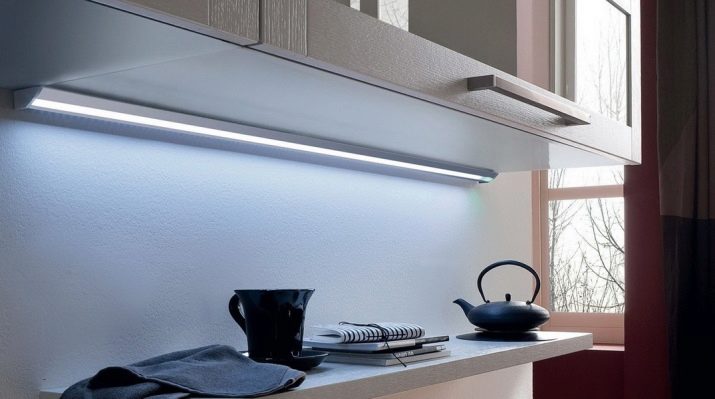
- Built-in LED spotlights in classic interiors give the kitchen a romantic look.
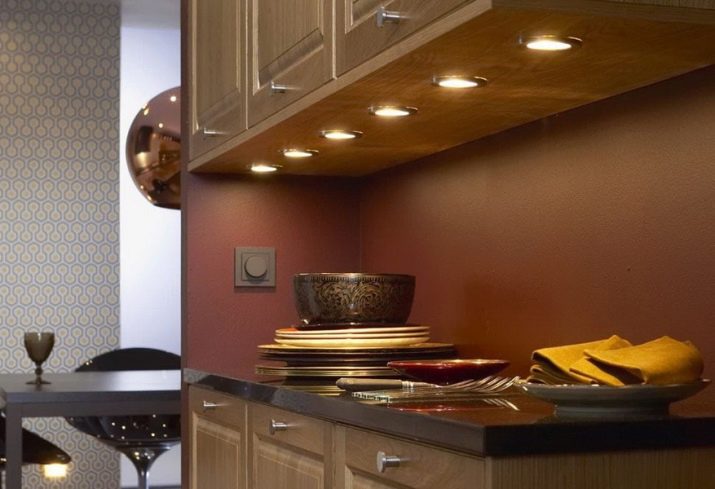
- Triangle surface-mounted luminaires are ideal for ultra-modern interiors.
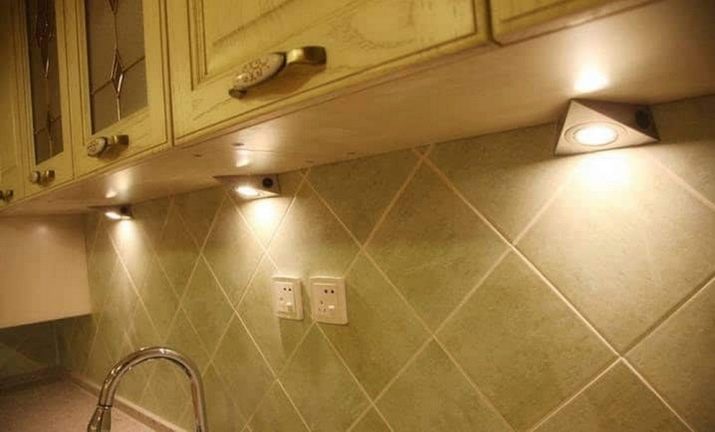
- Corner surface-mounted models on batteries are easy to install and are perfect for minimalism.
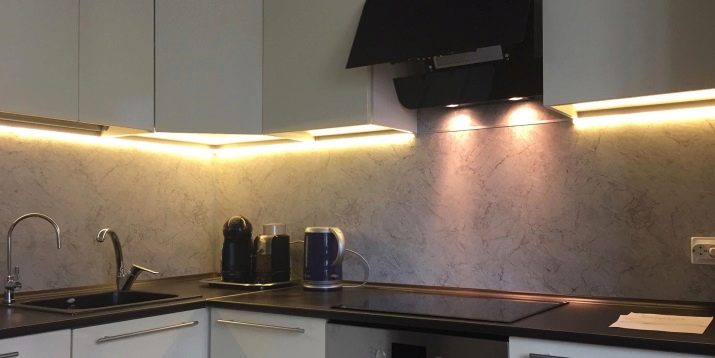
For information on how to make your own lighting for the kitchen cabinet, see the next video.








